外研版一起小学英语二年级上册全册教学设计
- 格式:doc
- 大小:649.00 KB
- 文档页数:111
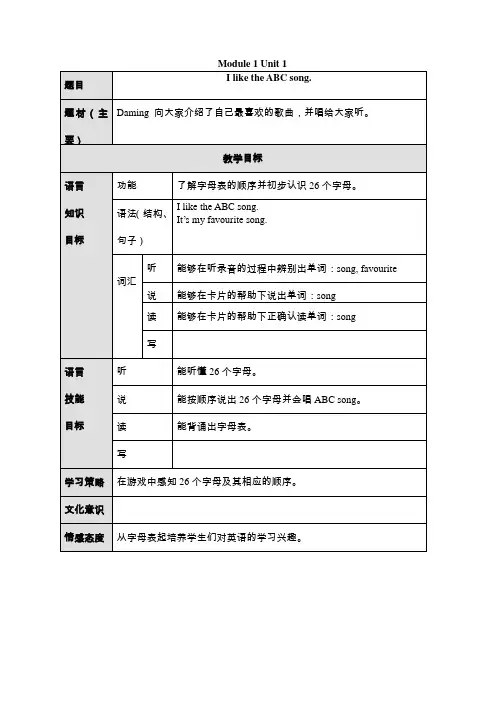
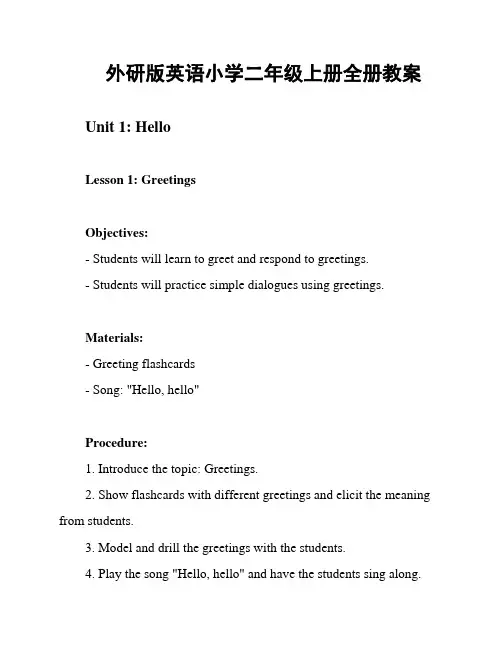
外研版英语小学二年级上册全册教案Unit 1: HelloLesson 1: GreetingsObjectives:- Students will learn to greet and respond to greetings.- Students will practice simple dialogues using greetings.Materials:- Greeting flashcards- Song: "Hello, hello"Procedure:1. Introduce the topic: Greetings.2. Show flashcards with different greetings and elicit the meaning from students.3. Model and drill the greetings with the students.4. Play the song "Hello, hello" and have the students sing along.5. Pair the students and have them practice the dialogues using greetings.6. Conduct a whole-class activity where students greet each other randomly.7. Wrap up the lesson by reviewing the greetings and singing the song again.Unit 2: My FamilyLesson 1: Family MembersObjectives:- Students will learn basic vocabulary for family members.- Students will practice using possessive pronouns.Materials:- Flashcards of family members- Picture cards of family members- Worksheet: Fill in the blanksProcedure:1. Introduce the topic: Family members.2. Show flashcards of family members and elicit the vocabulary from students.3. Model and drill the pronunciation of the family members' names.4. Show picture cards of family members and have the students identify and name them.5. Introduce possessive pronouns (my, your, his/her) and explain their usage.6. Give out the worksheet and ask students to fill in the blanks with the correct possessive pronouns.7. Check the answers as a class and provide feedback.8. Wrap up the lesson by reviewing the vocabulary and practicing the pronunciation.Unit 3: My SchoolLesson 1: School ObjectsObjectives:- Students will learn vocabulary for school objects.- Students will practice using basic prepositions of place.Materials:- Flashcards of school objects- Picture cards of school objects- Whiteboard or blackboardProcedure:1. Introduce the topic: School objects.2. Show flashcards of school objects and elicit the vocabulary from students.3. Model and drill the pronunciation of the school objects' names.4. Show picture cards of school objects and ask students to point to the objects as you name them.5. Introduce basic prepositions of place (on, in, under, beside) and explain their usage.6. Use the whiteboard or blackboard to draw a classroom scene and demonstrate the prepositions with the school objects.7. Pair the students and have them take turns giving directions using the prepositions and school objects.8. Wrap up the lesson by reviewing the vocabulary and practicing the pronunciation.*(Continue the format above for the remaining units and lessons)*。
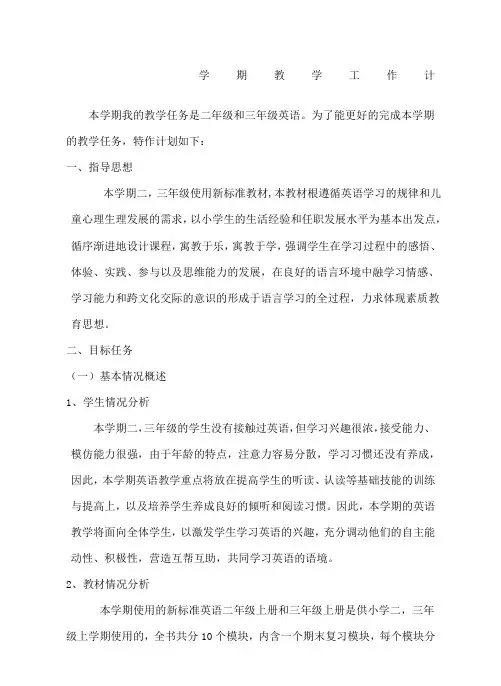
学期教学工作计本学期我的教学任务是二年级和三年级英语。
为了能更好的完成本学期的教学任务,特作计划如下:一、指导思想本学期二,三年级使用新标准教材,本教材根遵循英语学习的规律和儿童心理生理发展的需求,以小学生的生活经验和任职发展水平为基本出发点,循序渐进地设计课程,寓教于乐,寓教于学,强调学生在学习过程中的感悟、体验、实践、参与以及思维能力的发展,在良好的语言环境中融学习情感、学习能力和跨文化交际的意识的形成于语言学习的全过程,力求体现素质教育思想。
二、目标任务(一)基本情况概述1、学生情况分析本学期二,三年级的学生没有接触过英语,但学习兴趣很浓,接受能力、模仿能力很强,由于年龄的特点,注意力容易分散,学习习惯还没有养成,因此,本学期英语教学重点将放在提高学生的听读、认读等基础技能的训练与提高上,以及培养学生养成良好的倾听和阅读习惯。
因此,本学期的英语教学将面向全体学生,以激发学生学习英语的兴趣,充分调动他们的自主能动性、积极性,营造互帮互助,共同学习英语的语境。
2、教材情况分析本学期使用的新标准英语二年级上册和三年级上册是供小学二,三年级上学期使用的,全书共分10个模块,内含一个期末复习模块,每个模块分为两个单元。
一般情况下,第一单元呈现本模块所要学习的语言内容,第二单元提供若干任务型练习,包括一首儿歌和童谣。
(二)教学目标及要求a)初步形成学习英语的兴趣和爱好,在动态真实的环境中使用英语进行简单的活动的积极性。
b)能运用英语在日常生活和课堂情景中与老师同学进行日常简单交际,如:问候他人,询问有关个人、家庭和朋友的简单信息。
c)能运用英语参与课堂教学,游戏和其他课内外活动。
d)能够听懂简单的指令并做出正确反应,读懂简单小故事,会唱课本上出现的英文歌和歌谣,能分角色扮演课本中的英语小故事。
(三)教学重难点本学期继续以“任务为基础”(task-based)安排教学内容,采用全身反应法(TPR),组织学生在“身体运动”和“口腔运动”中学习。
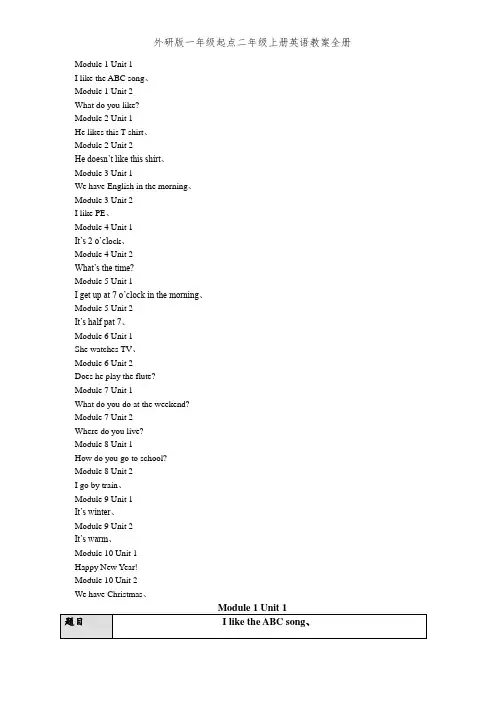
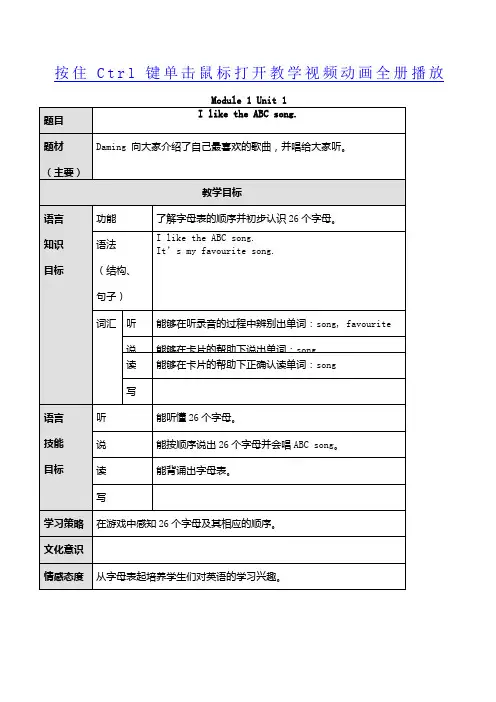
按住C t r l键单击鼠标打开教学视频动画全册播放Module 1 Unit 1题目I like the ABC song.题材(主要)Daming 向大家介绍了自己最喜欢的歌曲,并唱给大家听。
教学目标语言知识目标功能了解字母表的顺序并初步认识26个字母。
语法(结构、句子)I like the ABC song.It’s my favourite song.词汇听能够在听录音的过程中辨别出单词:song, favourite 说能够在卡片的帮助下说出单词:song读能够在卡片的帮助下正确认读单词:song写语言技能目标听能听懂26个字母。
说能按顺序说出26个字母并会唱ABC song。
读能背诵出字母表。
写学习策略在游戏中感知26个字母及其相应的顺序。
文化意识情感态度从字母表起培养学生们对英语的学习兴趣。
任务 1.Chain Game:可以在师生或学生小组间进行“字母接龙”的游戏;2.Letter Family:把字母卡(大小写共52张)打乱顺序分发到学生手中,让他们按大小写找到自己的搭档;3.在字母歌的帮助下,让他们按顺序列队;4.齐唱ABC song,复习、巩固26个字母。
按住Ctrl键单击鼠标打开教学视频动画全册播放Module 1 Unit 2题目What do you like?题材(主要)Panpan 和Baby panda在商店里购买玩具,并谈论各自最喜爱的玩具。
教学目标语言知识目标功能谈论个人的喜好。
语法(结构、句子)Do you like dolls/…? Yes, I do. / No, I don’t.What do you like? I like jigsaws/…词汇听能够在听对话录音的过程中辨别出单词:jigsaw, toy, bike 说能够看图说出单词:jigsaw, toy, bike读能够看图跟录音正确朗读单词:jigsaw, bike写语言技能目标听能够听懂Panpan与Baby panda间关于自己最喜爱玩具的谈论。
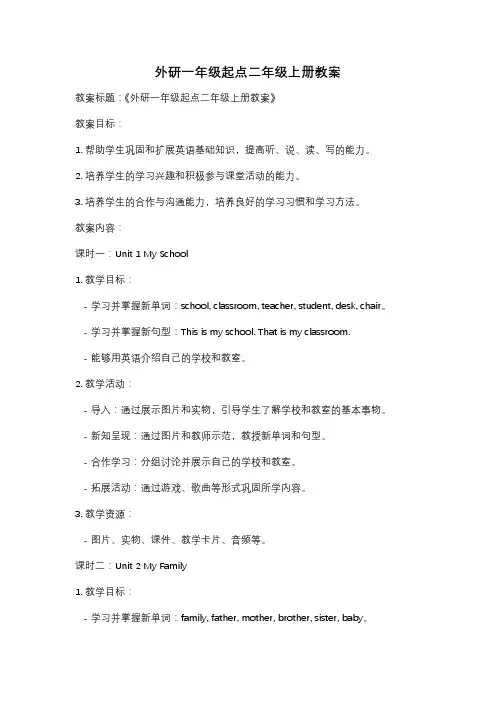
外研一年级起点二年级上册教案教案标题:《外研一年级起点二年级上册教案》教案目标:1. 帮助学生巩固和扩展英语基础知识,提高听、说、读、写的能力。
2. 培养学生的学习兴趣和积极参与课堂活动的能力。
3. 培养学生的合作与沟通能力,培养良好的学习习惯和学习方法。
教案内容:课时一:Unit 1 My School1. 教学目标:- 学习并掌握新单词:school, classroom, teacher, student, desk, chair。
- 学习并掌握新句型:This is my school. That is my classroom.- 能够用英语介绍自己的学校和教室。
2. 教学活动:- 导入:通过展示图片和实物,引导学生了解学校和教室的基本事物。
- 新知呈现:通过图片和教师示范,教授新单词和句型。
- 合作学习:分组讨论并展示自己的学校和教室。
- 拓展活动:通过游戏、歌曲等形式巩固所学内容。
3. 教学资源:- 图片、实物、课件、教学卡片、音频等。
课时二:Unit 2 My Family1. 教学目标:- 学习并掌握新单词:family, father, mother, brother, sister, baby。
- 学习并掌握新句型:This is my family. I have a father, a mother, a brother, and a sister.- 能够用英语介绍自己的家庭成员。
2. 教学活动:- 导入:通过展示图片和实物,引导学生了解家庭成员的基本事物。
- 新知呈现:通过图片和教师示范,教授新单词和句型。
- 合作学习:分组讨论并展示自己的家庭成员。
- 拓展活动:通过游戏、歌曲等形式巩固所学内容。
3. 教学资源:- 图片、实物、课件、教学卡片、音频等。
课时三:Unit 3 My Daily Routine1. 教学目标:- 学习并掌握新单词:get up, have breakfast, go to school, have lunch, go home, have dinner, go to bed。
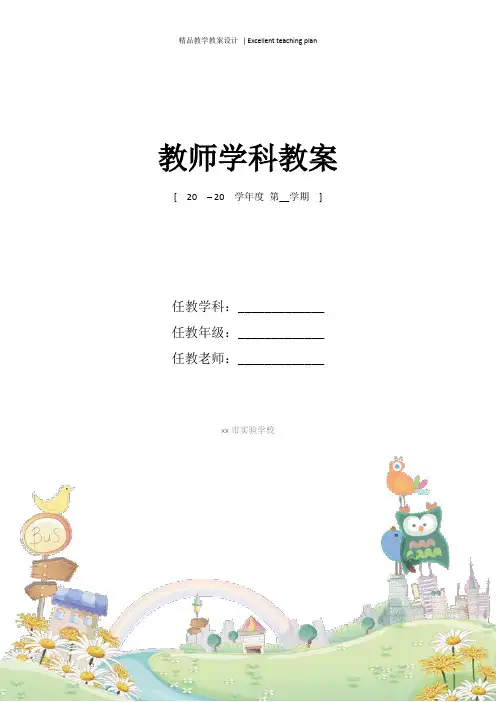
教师学科教案[ 20 – 20 学年度第__学期]任教学科:_____________任教年级:_____________任教老师:_____________xx市实验学校外研版英语全册教案Module 1 Unit 1I like the ABC song.Module 1 Unit 2What do you like?Module 2 Unit 1He likes this T-shirt.Module 2 Unit 2He doesn’t like this shirt.Module 3 Unit 1We have English in the morning.Module 3 Unit 2I like PE.Module 4 Unit 1It’s 2 o’clock.Module 4 Unit 2What’s the time?Module 5 Unit 1I get up at 7 o’clock in the morning.Module 5 Unit 2It’s half pat 7.Module 6 Unit 1She watches TV.Module 6 Unit 2Does he play the flute?Module 7 Unit 1What do you do at the weekend?Module 7 Unit 2Where do you live?Module 8 Unit 1How do you go to school?Module 8 Unit 2I go by train.Module 9 Unit 1It’s winter.Module 9 Unit 2It’s warm.Module 10 Unit 1Happy New Year!Module 10 Unit 2We have Christmas.Module 1 Unit 1Module 1 Unit 2Module 2 Unit 1Module 2 Unit 2Module 3 Unit 1Module 3 Unit 2Module 4 Unit 1Module 4 Unit 2Module 5 Unit 1Module 5 Unit 2Module 6 Unit 1Module 6 Unit 2Module 7 Unit 1Module 7 Unit 2Module 8 Unit 1Module 8 Unit 2Module 9 Unit 1Module 9 Unit 2Module 10 Unit 1Module 10 Unit 2精品教学教案设计| Excellent teaching plan育人犹如春风化雨,授业不惜蜡炬成灰。
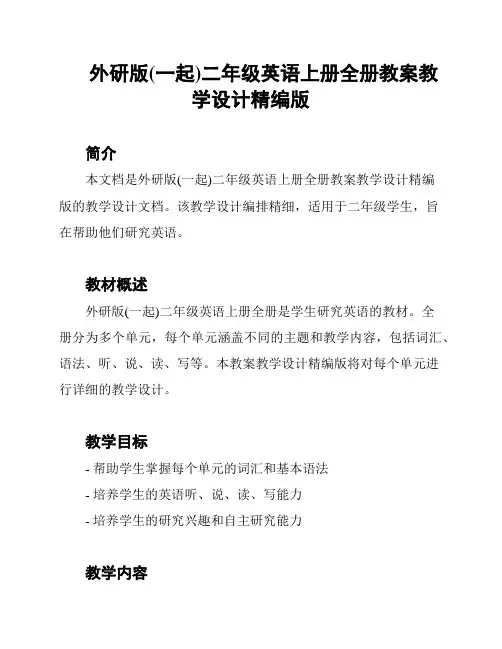
外研版(一起)二年级英语上册全册教案教
学设计精编版
简介
本文档是外研版(一起)二年级英语上册全册教案教学设计精编
版的教学设计文档。
该教学设计编排精细,适用于二年级学生,旨
在帮助他们研究英语。
教材概述
外研版(一起)二年级英语上册全册是学生研究英语的教材。
全
册分为多个单元,每个单元涵盖不同的主题和教学内容,包括词汇、语法、听、说、读、写等。
本教案教学设计精编版将对每个单元进
行详细的教学设计。
教学目标
- 帮助学生掌握每个单元的词汇和基本语法
- 培养学生的英语听、说、读、写能力
- 培养学生的研究兴趣和自主研究能力
教学内容
本文档中的教案教学设计精编版将包括每个单元的课堂活动、教学步骤、教学材料等内容。
通过丰富多样的教学活动,学生将能够积极参与和互动,提高他们的英语水平。
使用方法
教师可以根据本文档中的教学设计,按照教学步骤进行教学。
教材中的教学材料可以根据需要进行打印或投影展示。
结束语
外研版(一起)二年级英语上册全册教案教学设计精编版是一份帮助教师进行教学的文档。
通过严谨而有趣的教学设计,学生能够更好地研究英语,提高英语能力。
祝教师和学生教学愉快!。
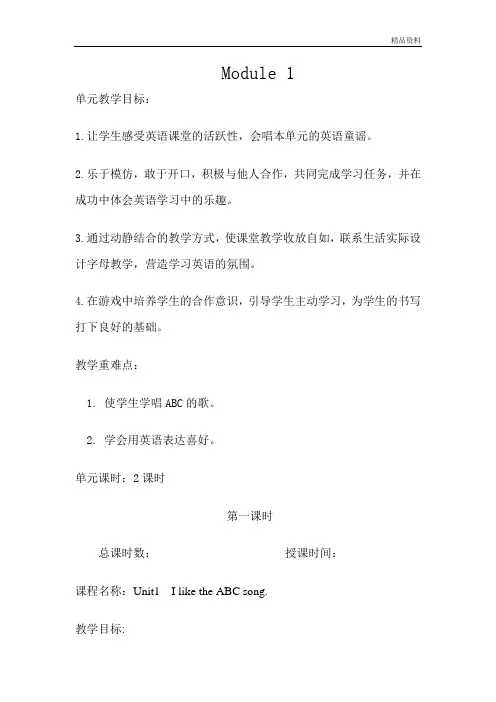
Module 1单元教学目标:1.让学生感受英语课堂的活跃性,会唱本单元的英语童谣。
2.乐于模仿,敢于开口,积极与他人合作,共同完成学习任务,并在成功中体会英语学习中的乐趣。
3.通过动静结合的教学方式,使课堂教学收放自如,联系生活实际设计字母教学,营造学习英语的氛围。
4.在游戏中培养学生的合作意识,引导学生主动学习,为学生的书写打下良好的基础。
教学重难点:1. 使学生学唱ABC的歌。
2. 学会用英语表达喜好。
单元课时:2课时第一课时总课时数:授课时间:课程名称:Unit1 I like the ABC song.教学目标:1.通过学习字母歌,重点认读26个字母。
2.听懂句子I like the ABC song. It’s my favourite song.3.了解字母在字母表中的顺序。
4.让学生感受英语课堂的活跃性,会唱本单元的英语童谣。
教学重点:1.能听懂、会说、会读以下句子:I like the ABC song.It’s my favourite song.2.会说唱本单元的英语童谣《ABC》教学难点:1.熟练掌握字母和句子,能在实际生活中灵活运用。
2.培养学生用英语思维的能力,及大胆用英语交流的能力。
教学过程:Step 1.Warming-up1.教师热情地和学生打招呼,师生或学生之间相互问好。
教师和学生就爱好用I like…I don’t like…Step2.Presentation在师生互相介绍自己喜好的基础上,教师适时呈现本课任务:你们知道我们的好朋友Daming最喜爱的活动是什么吗?他最爱的活动是唱歌。
你们想知道是什么歌吗?学习完本单元之后,你就知道了!Step3.Practice开展“字母顺序接力赛”活动:把两套有字母大小写的卡片分别打乱次序贴在黑板两侧,然后将全班分成男女两组。
游戏开始后,各组依次上来一个学生,以接力的方式,一人移动一个字母,按字母表的顺序重新排列,看哪组最快最准确。
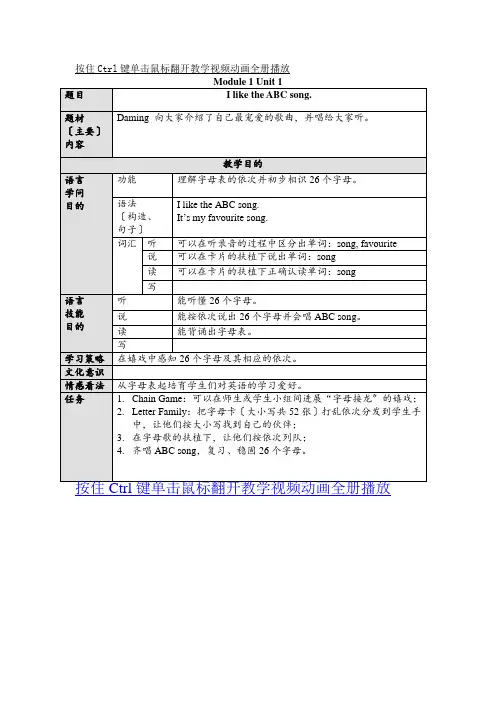
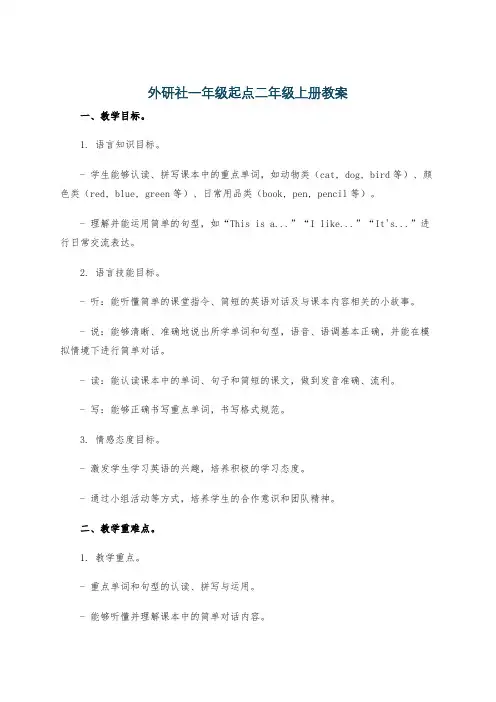
外研社一年级起点二年级上册教案一、教学目标。
1. 语言知识目标。
- 学生能够认读、拼写课本中的重点单词,如动物类(cat, dog, bird等)、颜色类(red, blue, green等)、日常用品类(book, pen, pencil等)。
- 理解并能运用简单的句型,如“This is a...”“I like...”“It's...”进行日常交流表达。
2. 语言技能目标。
- 听:能听懂简单的课堂指令、简短的英语对话及与课本内容相关的小故事。
- 说:能够清晰、准确地说出所学单词和句型,语音、语调基本正确,并能在模拟情境下进行简单对话。
- 读:能认读课本中的单词、句子和简短的课文,做到发音准确、流利。
- 写:能够正确书写重点单词,书写格式规范。
3. 情感态度目标。
- 激发学生学习英语的兴趣,培养积极的学习态度。
- 通过小组活动等方式,培养学生的合作意识和团队精神。
二、教学重难点。
1. 教学重点。
- 重点单词和句型的认读、拼写与运用。
- 能够听懂并理解课本中的简单对话内容。
2. 教学难点。
- 句型在实际情境中的灵活运用。
- 部分单词的发音,如“bird”中的“ir”发音。
三、教学方法。
1. 情景教学法。
- 通过创设各种生活情景,如动物园、文具店等,帮助学生更好地理解和运用所学单词和句型。
2. 游戏教学法。
- 采用游戏的方式,如单词接龙、猜动物等,增加学习的趣味性,提高学生的参与度。
3. 直观教学法。
- 运用图片、实物等直观教具展示单词内容,让学生更直观地感受和记忆单词。
四、教学过程。
(一)导入(5分钟)1. Greeting.- 教师走进教室,与学生热情打招呼:“Good morning, boys and girls.”引导学生回应:“Good morning, teacher.”2. Lead - in.- 教师展示一个神秘的盒子,说:“Look! I have a magic box today. There are many interesting things in it. Do you want to know what are they?”激发学生的好奇心,从而引出本节课的内容。
Module 1单元教学目标:1.让学生感受英语课堂的活跃性,会唱本单元的英语童谣。
2.乐于模仿,敢于开口,积极与他人合作,共同完成学习任务,并在成功中体会英语学习中的乐趣。
3.通过动静结合的教学方式,使课堂教学收放自如,联系生活实际设计字母教学,营造学习英语的氛围。
4.在游戏中培养学生的合作意识,引导学生主动学习,为学生的书写打下良好的基础。
教学重难点:1. 使学生学唱ABC的歌。
2. 学会用英语表达喜好。
单元课时:2课时第一课时总课时数:授课时间:课程名称:Unit1 I like the ABC song.教学目标:1.通过学习字母歌,重点认读26个字母。
2.听懂句子I like the ABC song. It’s my favourite song.3.了解字母在字母表中的顺序。
4.让学生感受英语课堂的活跃性,会唱本单元的英语童谣。
教学重点:1.能听懂、会说、会读以下句子:I like the ABC song.It’s my favourite song.2.会说唱本单元的英语童谣《ABC》教学难点:1.熟练掌握字母和句子,能在实际生活中灵活运用。
2.培养学生用英语思维的能力,及大胆用英语交流的能力。
教学过程:Step 1.Warming-up1.教师热情地和学生打招呼,师生或学生之间相互问好。
教师和学生就爱好用I like…I don’t like…Step2.Presentation在师生互相介绍自己喜好的基础上,教师适时呈现本课任务:你们知道我们的好朋友Daming最喜爱的活动是什么吗?他最爱的活动是唱歌。
你们想知道是什么歌吗?学习完本单元之后,你就知道了!Step3.Practice开展“字母顺序接力赛”活动:把两套有字母大小写的卡片分别打乱次序贴在黑板两侧,然后将全班分成男女两组。
游戏开始后,各组依次上来一个学生,以接力的方式,一人移动一个字母,按字母表的顺序重新排列,看哪组最快最准确。
学期教学工作计本学期我的教学任务是二年级和三年级英语。
为了能更好的完成本学期的教学任务,特作计划如下:一、指导思想本学期二,三年级使用新标准教材,本教材根遵循英语学习的规律和儿童心理生理发展的需求,以小学生的生活经验和任职发展水平为基本出发点,循序渐进地设计课程,寓教于乐,寓教于学,强调学生在学习过程中的感悟、体验、实践、参与以及思维能力的发展,在良好的语言环境中融学习情感、学习能力和跨文化交际的意识的形成于语言学习的全过程,力求体现素质教育思想。
二、目标任务(一)基本情况概述1、学生情况分析本学期二,三年级的学生没有接触过英语,但学习兴趣很浓,接受能力、模仿能力很强,由于年龄的特点,注意力容易分散,学习习惯还没有养成,因此,本学期英语教学重点将放在提高学生的听读、认读等基础技能的训练与提高上,以及培养学生养成良好的倾听和阅读习惯。
因此,本学期的英语教学将面向全体学生,以激发学生学习英语的兴趣,充分调动他们的自主能动性、积极性,营造互帮互助,共同学习英语的语境。
2、教材情况分析本学期使用的新标准英语二年级上册和三年级上册是供小学二,三年级上学期使用的,全书共分10个模块,内含一个期末复习模块,每个模块分为两个单元。
一般情况下,第一单元呈现本模块所要学习的语言内容,第二单元提供若干任务型练习,包括一首儿歌和童谣。
(二)教学目标及要求a) 初步形成学习英语的兴趣和爱好,在动态真实的环境中使用英语进行简单的活动的积极性。
b)能运用英语在日常生活和课堂情景中与老师同学进行日常简单交际,如:问候他人,询问有关个人、家庭和朋友的简单信息。
c) 能运用英语参与课堂教学,游戏和其他课内外活动。
d) 能够听懂简单的指令并做出正确反应,读懂简单小故事,会唱课本上出现的英文歌和歌谣,能分角色扮演课本中的英语小故事。
(三)教学重难点本学期继续以“任务为基础”(task-based)安排教学内容,采用全身反应法(TPR),组织学生在“身体运动”和“口腔运动”中学习。
外研版(一起)二年级英语上册全册教案课程概述本套教案为外研版(一起)二年级英语上册全册的教案,总共包含多个单元,旨在帮助学生掌握基本的英语词汇和句子结构,培养他们的听、说、读、写的能力。
教学目标1. 了解并熟练掌握每一单元中的词汇、句型和语法知识。
2. 能够运用所学的知识进行基本的听、说、读、写训练。
3. 培养学生的英语研究兴趣和研究策略,提高研究效果。
4. 培养学生的合作意识和团队合作能力。
教学内容教案的内容根据每个单元的主题进行编排。
每个单元包括以下部分:1. 单元主题介绍2. 目标词汇和句型3. 听力训练4. 口语训练5. 读写训练6. 巩固练7. 小结与评价教学方式教师以情境化和互动式的方式进行授课,注重学生的参与和合作。
教学过程中,可以采用多媒体教学、游戏活动、小组合作等形式,激发学生的研究兴趣和积极性。
教学评价教学评价分为形ative Assessment和Summative Assessment两种形式。
形ative Assessment旨在帮助教师了解学生的研究进展和困难,及时调整教学策略。
Summative Assessment则用于评估学生对整个教材内容的掌握程度。
教学资源本教案需要准备的教学资源包括教材、多媒体设备、图片、游戏道具等。
教案编写者本教案由(您的姓名)编写,根据《外研版(一起)二年级英语上册全册教材》编写而成。
以上是《外研版(一起)二年级英语上册全册教案》的基本信息。
教师可以根据教学实际情况,按照本教案的框架进行教学,根据学生的实际情况进行适当的调整和补充。
祝教学顺利!。
外研版一年级起点二年级上册英语教案全册I like the ABC song.Module 1 Unit 2What do you like?Module 2 Unit 1He likes this T-shirt.Module 2 Unit 2He doesn ’ t like this shirt.Module 3 Unit 1We have English in the morning.Module 3 Unit 2I like PE.Module 4 Unit 1It ’ s 2 o’ clock.Module 4 Unit 2What’ s the time?Module 5 Unit 1I get up at 7 o’ clock in the morning.Module 5 Unit 2It ’ s halfatp7.Module 6 Unit 1She watches TV.Module 6 Unit 2Does he play the flute?Module 7 Unit 1What do you do at the weekend?Module 7 Unit 2Where do you live?Module 8 Unit 1How do you go to school?Module 8 Unit 2I go by train.Module 9 Unit 1It ’ s winter.Module 9 Unit 2It ’ s warm.Module 10 Unit 1Happy New Year!Module 10 Unit 2We have Christmas.题目题材(主要)内容语言知识目标语言技能目标学习策略文化意识情感态度任务I like the ABC song.Daming 向大家介绍了自己最喜欢的歌曲,并唱给大家听。
教学目标功能了解字母表的顺序并初步认识 26 个字母。
矿产资源开发利用方案编写内容要求及审查大纲
矿产资源开发利用方案编写内容要求及《矿产资源开发利用方案》审查大纲一、概述
㈠矿区位置、隶属关系和企业性质。
如为改扩建矿山, 应说明矿山现状、
特点及存在的主要问题。
㈡编制依据
(1简述项目前期工作进展情况及与有关方面对项目的意向性协议情况。
(2 列出开发利用方案编制所依据的主要基础性资料的名称。
如经储量管理部门认定的矿区地质勘探报告、选矿试验报告、加工利用试验报告、工程地质初评资料、矿区水文资料和供水资料等。
对改、扩建矿山应有生产实际资料, 如矿山总平面现状图、矿床开拓系统图、采场现状图和主要采选设备清单等。
二、矿产品需求现状和预测
㈠该矿产在国内需求情况和市场供应情况
1、矿产品现状及加工利用趋向。
2、国内近、远期的需求量及主要销向预测。
㈡产品价格分析
1、国内矿产品价格现状。
2、矿产品价格稳定性及变化趋势。
三、矿产资源概况
㈠矿区总体概况
1、矿区总体规划情况。
2、矿区矿产资源概况。
3、该设计与矿区总体开发的关系。
㈡该设计项目的资源概况
1、矿床地质及构造特征。
2、矿床开采技术条件及水文地质条件。